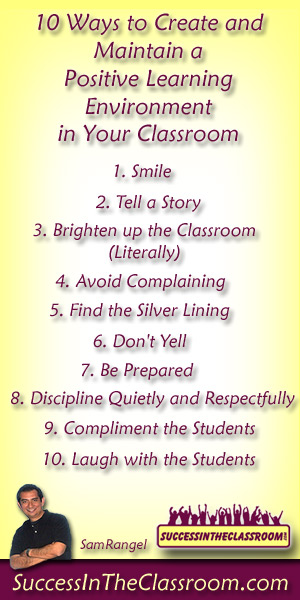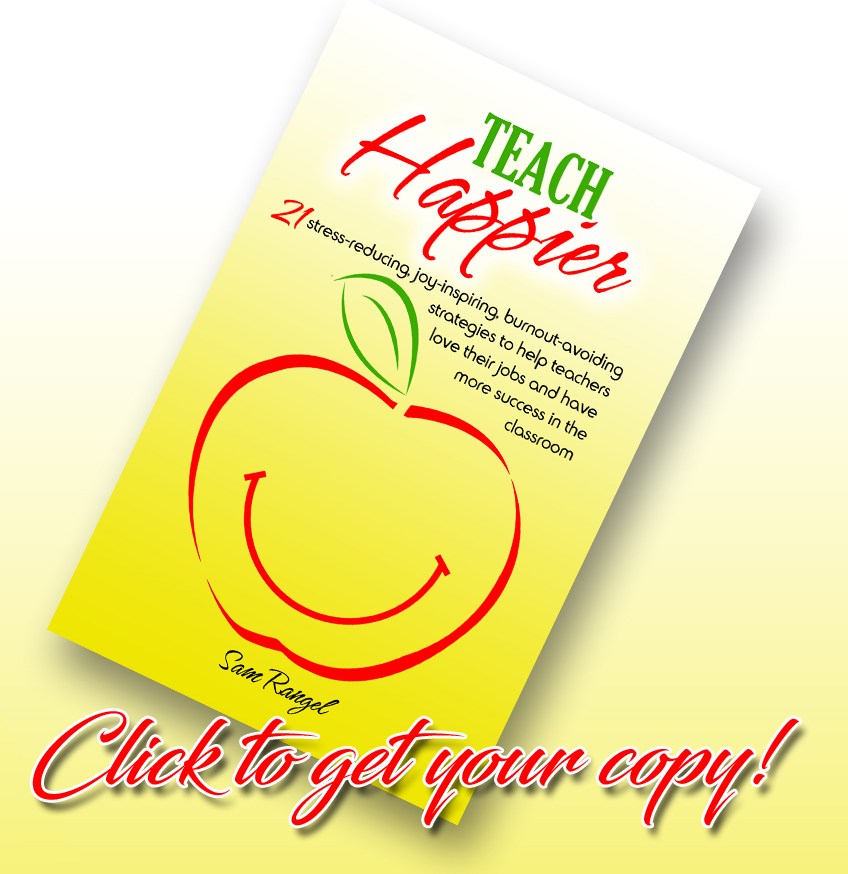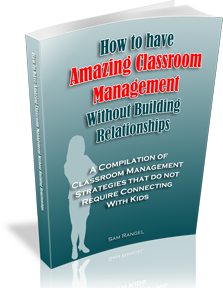With the school year starting up again, one of the objectives of many teachers is to create a positive classroom environment.
Teachers want to have that class where every student is smiling and anxious to learn. Am I right?
Unfortunately, creating this kind of environment is work. It doesn’t come automatically. In fact, there are so many outside influences that try to destroy your positive environment. You have that student with the attitude. There is the broken air conditioner. There are the stresses at home, etc.
Although it won’t always be “rainbows and unicorns,” you can still create an environment in your classroom where students leave happy and you can end the day without having any of your hair pulled out.
Like I said, however, it takes work. It takes preparation and planning. It takes a teacher who understands that the credit for a positive classroom environment or the blame for a negative environment falls only on him or her.
“But you don’t know my students, Sam”
I know. I’ve heard this before. I have heard teachers blame the negativity in the classroom on “that” student or “that group of students”.
I don’t buy this. I’ve had “that” student in my class, and what I’ve discovered is that when “that” student wants bring my class down, I just have to work harder to maintain that positive energy. I made a decision long ago that I was going to be the one to control the “environmental thermostat” and not “that” student. It meant that I was going to make a conscious effort to control my classrooms environment.
How do you do this, Sam?
I’m glad you asked.
Here are 10 Ways to Create and Maintain a Positive Learning Environment in Your Classroom
1. Smile
I’m not a natural smiler. In fact, people say that I look mad all the time. I have found, however, that when I sense the negative energy entering my classroom, instead of getting serious, I start to smile. Smiling has a way of putting people at ease. Plus, it makes you feel better too.
2. Tell a Story
Students like stories. Everybody likes stories. It’s OK to pause the lesson and relate a personal, and better yet, a funny story about the topic you’re studying. It brings the level of tension down, and it puts you back in control of the time, instead of focusing on outside influences.
3. Brighten up the Classroom (Literally)
Open the blinds. Turn on all lights. I’ve found that a dark classroom attracts negativity.
4. Avoid Complaining
Don’t bring your personal problems into the classroom. If your back hurts or if your car is in the shop or if the teacher across the hall took your stapler, keep it a secret from your students. Don’t contribute to the negativity.
5. Find the Silver Lining
If the air conditioning breaks down, don’t start shaking your head. Find something positive to say about it. Everybody already know how bad it is. Be the one to remind them of the positive: “Well at least that’s going to save the district money on electricity.” (I know that is a bad example, but you get the idea.)
6. Don’t Yell
The best way to destroy a positive environment is for you to let your emotions get the best of you and start yelling at a student or the class. You can’t bring those positive feelings back after you’ve gone off on the kids. You can tell all the funny stories you want, but you won’t be able to disperse the cloud of negativity in the room that’s created when you lose your temper.
7. Be Prepared
In my 8th grade class, if I tried to wing-it during a lesson, I would more-times-than-not find myself working extra hard to keep that positive feeling. Keeping the students engaged makes keeping the positive environment easier. Notice I said “easier” and not “easy.”
8. Discipline Quietly and Respectfully
If you have a student who is trying to take the attention away from you, and you have to give him/her a consequence, don’t make a big deal about it. Don’t disrespect him/her in front of his/her classmates. I understand that sometimes a teacher has to make an example of a student to teach a greater lesson to the class and re-establish his/her authority, but it needs to be done respectfully. If possible, call the student up to your desk or have him/her meet you outside. Never yell or humiliate a student. It’s tough to discipline a student AND keep the positive environment, but it is possible. The key is showing the student respect (even if his actions totally disrespected you).
9. Compliment the Students
Everybody likes compliments. Compliments make us smile. We can be having the worst day ever, and someone can come and tell us how they like our shirt or tie or haircut, and for that moment we forget about what’s ruining our day. Right? Start the class off by welcoming the students as they come in the door and saying things like, “I like that binder;” or “I like your shirt;” or “Did you get a haircut? Looks good!” Keep track of what students tell you about their lives, and in the middle of the lesson, pretend you just remembered something, and say things like, “Hey Johnny, didn’t you just get a baby sister? Congratulations.” Compliments just have a way of attracting those good feelings back into the room.
10. Laugh with the Students
Don’t be afraid to laugh with the kids. They are funny. They do funny things. They say funny things. If it’s funny laugh. Even if it’s not funny, but they think it’s funny, laugh. If you make a mistake, laugh about it. Let them laugh at you. After a few seconds, just say, “OK, that was funny, now let’s get back to the lesson.” If yelling destroys the positive environment, laughing has the opposite effect.
There you have it, 10 Ways to Create and Maintain a Positive Learning Environment in Your Classroom.
Hope they were helpful. If you would like to add to the list, please do so by commenting below.
A special thank you to all those who have been tweeting, Facebooking, and pinning my posts around the web. It is very much appreciated.
Until next time,
Here’s to your Success In the Classroom!
Thanks,
Sam



